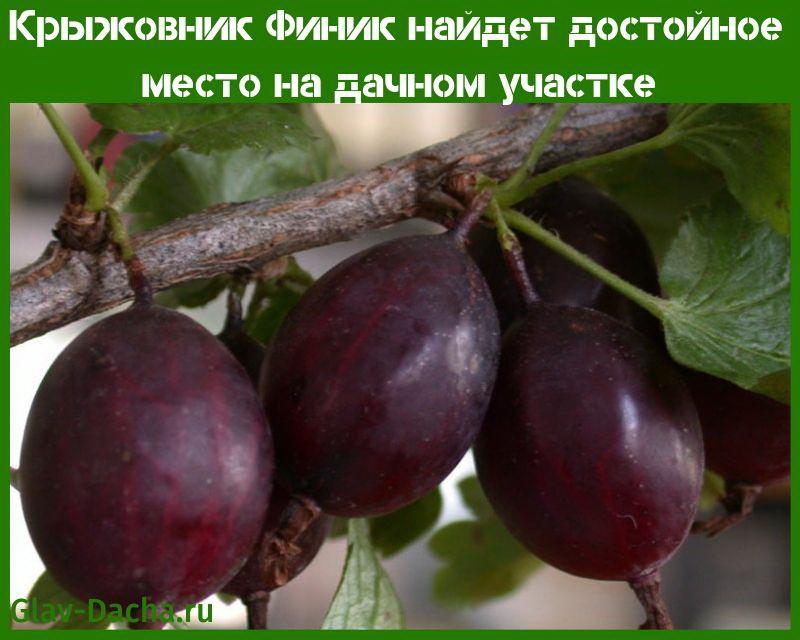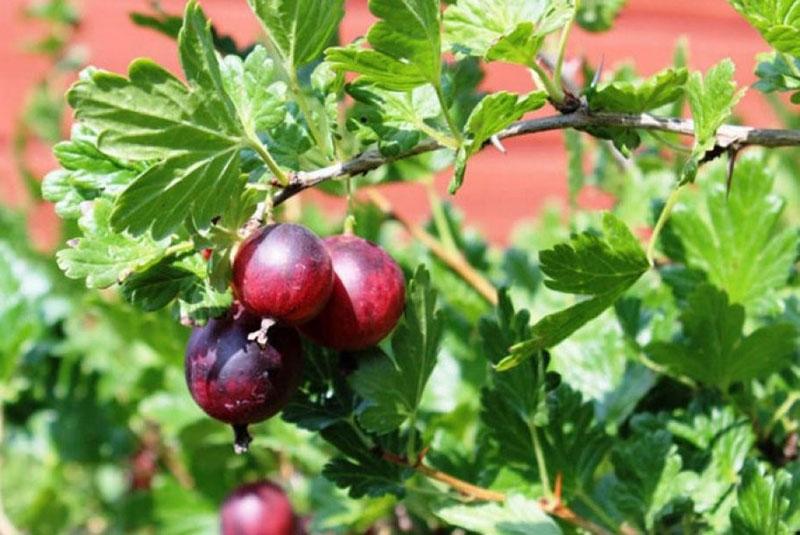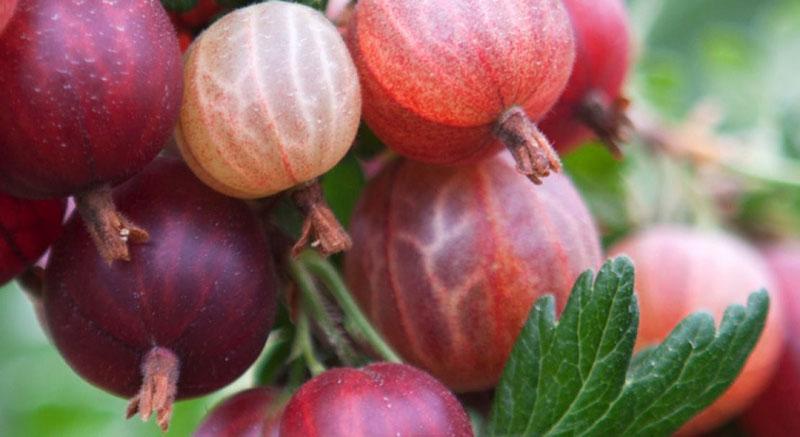Gooseberry Date will find a worthy place at their summer cottage
 Gooseberry Date is one of the famous varieties of European selection. Its popularity is due to its large berry size and high crop yield. The unpretentiousness of the variety makes it attractive even for not too experienced gardeners.
Gooseberry Date is one of the famous varieties of European selection. Its popularity is due to its large berry size and high crop yield. The unpretentiousness of the variety makes it attractive even for not too experienced gardeners.
What gooseberry dates look like

The description of the gooseberry variety Date necessarily includes a mention of berries that are used in raw food and for harvesting for the winter. They are large, sweet and sour, with a dense rind, which, on the sunny side, has an intense purple color. In an adult plant, the fruits are large, up to 20 g in weight.
Distinctive features of the variety:
- Fruiting in full begins 4-5 years after planting the seedling.
- Harvest from an adult bush - up to 13 kg of berries per season.
- The berries ripen in August.
- Pollination of flowers with pollen of their own variety leads to the formation of ovaries.
You don't have to rush to harvest - the berries, without loss of quality, remain on the branches even 20 days after ripening.
Advantages and disadvantages of the variety
 Date gooseberry compares favorably with other varieties with a large list of advantages.
Date gooseberry compares favorably with other varieties with a large list of advantages.
These include the following:
- high taste;
- good productivity;
- frost resistance of the variety (resistance to temperature drop down to -35 ° C);
- the possibility of long-term storage of the crop;
- drought resistance;
- convenience of transportation of the crop;
- high and long-term productivity;
- undemanding care.
There were also some drawbacks. The disadvantages of the gooseberry Date are:
- deterioration in yield in case of violation of the rules of plant care;
- exactingness to the composition of the soil;
- ripening (in comparison with other varieties) - later;
- there is susceptibility to diseases (root aphids, powdery mildew).
The productivity of the bush lasts for about 17 years, subject to proper care.
Planting and rules for caring for gooseberries Date
 If a decision is made to grow this variety, it is necessary to take into account the planting and care requirements of the Date gooseberry. One of them is the need to plant a plant away from currants and fruit trees... Otherwise, the growth of the shrub will be inhibited, its yield will decrease, the berries will become smaller in size.
If a decision is made to grow this variety, it is necessary to take into account the planting and care requirements of the Date gooseberry. One of them is the need to plant a plant away from currants and fruit trees... Otherwise, the growth of the shrub will be inhibited, its yield will decrease, the berries will become smaller in size.
Why soil acidification should not be allowed
 The potting soil for this gooseberry variety should be neutral. Violation of this requirement will immediately affect the taste of the berries and the abundance of the harvest. In acidic soil, liming must be carried out by adding dolomite flour or lime to the soil.
The potting soil for this gooseberry variety should be neutral. Violation of this requirement will immediately affect the taste of the berries and the abundance of the harvest. In acidic soil, liming must be carried out by adding dolomite flour or lime to the soil.
This technique will also reduce the likelihood of damage to shrubs by pests and pathogens.
 For planting a seedling, holes are prepared. Mineral and organic fertilizers are applied to them. After the bush is planted, the soil surface under it is mulched.
For planting a seedling, holes are prepared. Mineral and organic fertilizers are applied to them. After the bush is planted, the soil surface under it is mulched.
Looking for the best landing spot
 The best place in the garden for the Date variety is a light one, located above the groundwater. Wells are best cooked in the fall.If you plan to plant several bushes, then between the rows it is necessary to maintain a distance of 2 m, and in each of the rows - 1.5 m from one plant to another. It is advisable to make the holes about 0.5 m deep and about 0.6 x 0.6 m in size.
The best place in the garden for the Date variety is a light one, located above the groundwater. Wells are best cooked in the fall.If you plan to plant several bushes, then between the rows it is necessary to maintain a distance of 2 m, and in each of the rows - 1.5 m from one plant to another. It is advisable to make the holes about 0.5 m deep and about 0.6 x 0.6 m in size.
How to influence yield
 To increase the yield will help not only the timely feeding of the bush, but also sanitary pruning of the shoots.
To increase the yield will help not only the timely feeding of the bush, but also sanitary pruning of the shoots.
Trimming is carried out in two cases:
- Formation of the desired crown.
- Sanitary thinning.
Sanitary cleaning is the prevention of thickening of the bush, removal of diseased or dry branches. With an excessive density of the Date, it becomes susceptible to powdery mildew damage.
Scheduled pruning should be performed:
- in spring - before the start of growth;
- in the fall - after the seasonal fall of leaves.
It is important that branches of different ages are present on the bush.
The need for top dressing is determined by the quality of the soil. If the conditions are favorable - the soil is fertile and there is no acidification, then before fruiting, you can not make additional fertilizing. Otherwise, it is recommended to apply potash and phosphate fertilizers.
Moderate watering
 Since stagnation of moisture is undesirable for gooseberries, this circumstance must be taken into account when watering. The optimal soil moisture schedule is 2 times a month, 10 liters of water per adult bush. If the weather is dry, then watering should be carried out more often and more abundantly.
Since stagnation of moisture is undesirable for gooseberries, this circumstance must be taken into account when watering. The optimal soil moisture schedule is 2 times a month, 10 liters of water per adult bush. If the weather is dry, then watering should be carried out more often and more abundantly.
Preventive measures
 At the first signs of a disease affecting a shrub, it is necessary to immediately take retaliatory measures - to treat the plant with special means. If there are pests on the gooseberry, Fitoverm is often used, which is used according to the scheme indicated on the package.
At the first signs of a disease affecting a shrub, it is necessary to immediately take retaliatory measures - to treat the plant with special means. If there are pests on the gooseberry, Fitoverm is often used, which is used according to the scheme indicated on the package.
If the gooseberry is affected by powdery mildew, then it is necessary to prevent its spread to healthy plants. To do this, the infected shrub must be completely uprooted. And use as a means of prevention, for example, Topaz.
Gooseberry variety Date is a plant that, with proper care, will delight with a bountiful harvest for many years. This is an unpretentious shrub that does not require much effort to grow, and the presence of significant experience.